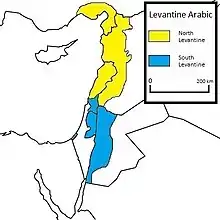North Levantine Arabic
North Levantine Arabic (Arabic: اللهجة الشامية الشمالية, romanized: al-lahja š-šāmiyya š-šamāliyya, North Levantine Arabic: il-lahje š-šāmiyye š-šmāliyye) is a subdivision of Levantine Arabic, a variety of Arabic. It stems from the north in Turkey, specifically in the coastal regions of the Adana, Hatay, and Mersin provinces,[2][3] to Lebanon,[4][2] passing through the Mediterranean coastal regions of Syria (the Latakia and Tartus governorates) as well as the areas surrounding Aleppo and Damascus.[2][5] It is also known as Syro-Lebanese Arabic,[2] though that term is sometimes used to mean all of Levantine Arabic.[6]
| North Levantine Arabic | |
|---|---|
| اللهجة الشامي الشمال | |
| Native to | Lebanon, Syria, Chukurova (Turkey) |
Native speakers | 24.6 million (2016)[1] |
Afro-Asiatic
| |
| Dialects | |
| Arabic alphabet | |
| Language codes | |
| ISO 639-3 | apc |
| Glottolog | nort3139 |
 | |
With over 24 million native speakers worldwide as of 2015,[2] Northern Levantine Arabic is used for daily speech mainly in Lebanon and Syria, while most of the written and official documents and media use Modern Standard Arabic. Its dialect continuum has been described as one of the two "dominant (prestigeful) dialect centres of gravity for Spoken Arabic".[7]
Dialects
- Syria: The dialect of Damascus and the dialect of Aleppo are well-known.[2]
- Lebanon: North Lebanese, South Lebanese (Metuali, Shii), North-Central Lebanese (Mount Lebanon Arabic), South-Central Lebanese (Druze Arabic), Standard Lebanese, Beqaa, Sunni Beiruti, Saida Sunni, Iqlim-Al-Kharrub Sunni, Jdaideh[2]
- Çukurova, Turkey: Cilician/Çukurovan[2]
References
- "Arabic, North Levantine Spoken". Ethnologue. Retrieved 2018-08-08.
- "Arabic, North Levantine Spoken". Ethnologue. Retrieved 2018-07-16.
- "Turkey". Ethnologue. Retrieved 2018-07-16.
- "Glottolog 3.2 - North Levantine Arabic". glottolog.org. Retrieved 2018-07-16.
- "Jordan and Syria". Ethnologue. Retrieved 2018-07-16.
- Versteegh, Kees (2009). Encyclopedia of Arabic language and linguistics. Leiden: Brill. p. 170. ISBN 9789004177024. OCLC 401165899.
- Decker, Donald M. (1999). Handbook of the International Phonetic Association: A Guide to the Use of the International Phonetic Alphabet. Cambridge, United Kingdom: Cambridge University Press. p. 51. ISBN 9780521637510.